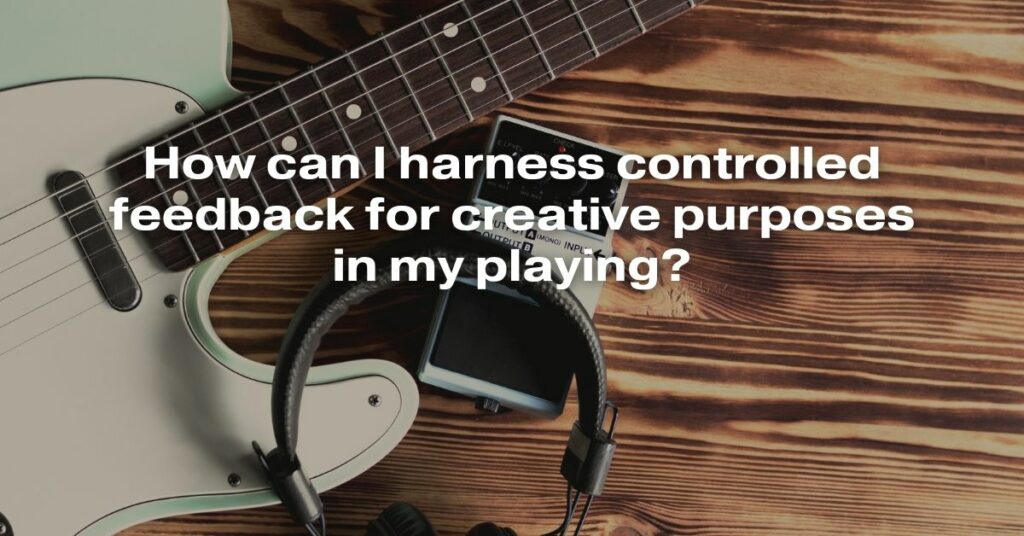Music, at its core, is a form of self-expression, and musicians are constantly seeking new ways to infuse their creativity into their playing. One innovative technique that has gained popularity among musicians across various genres is controlled feedback. Harnessing controlled feedback can elevate your playing to new heights, adding a unique dimension to your music. In this article, we will explore what controlled feedback is, how it can be harnessed, and how you can use it to enhance your musical creativity.
Understanding Controlled Feedback
Feedback occurs when the sound produced by an amplifier is picked up by a guitar or other instrument, creating a loop of sound that can be manipulated by the player. While uncontrolled feedback can be unpredictable and disruptive, controlled feedback is a deliberate and artistic technique employed by musicians to add depth and texture to their sound. Mastering this technique opens up a world of creative possibilities, allowing you to produce expressive, otherworldly tones.
Mastering the Basics
Before diving into the realm of controlled feedback, it’s essential to have a strong command over your instrument. Familiarize yourself with the intricacies of your guitar, understanding how different notes and techniques affect the feedback produced. Experiment with sustain, vibrato, and bending notes to find the sweet spot where feedback naturally occurs.
Choosing the Right Gear
Selecting the appropriate gear is crucial when working with controlled feedback. High-gain amplifiers and distortion pedals can help amplify the sound, making it easier to control and manipulate the feedback. Experiment with various pedals, such as delay and reverb, to add complexity and depth to the feedback tones. Additionally, using a guitar with a humbucking pickup can reduce unwanted noise and enhance the clarity of the feedback.
Techniques for Controlled Feedback
Volume and Distance: Controlling the distance between your guitar and the amplifier can significantly impact the feedback. Experiment with different distances to find the point where the feedback is strong but manageable. Adjusting the volume knob on your guitar can also help modulate the intensity of the feedback.
Harmonics and Overtones: Playing harmonics and overtones can enhance the complexity of the feedback. Experiment with natural harmonics, pinch harmonics, and artificial harmonics to create interesting and dynamic feedback patterns.
Feedback Loops: Creating feedback loops involves manipulating the sound waves by changing the position of your guitar and amplifier. Move around the stage to find spots where the feedback is strongest, and use your body and instrument to control the feedback’s pitch and intensity.
String Bending and Vibrato: Incorporating string bending and vibrato techniques can add expressiveness to your feedback. By bending notes or applying vibrato, you can subtly change the pitch and texture of the feedback, creating a more melodic and musical effect.
Incorporating Controlled Feedback into Your Playing
Once you have mastered the techniques, it’s time to incorporate controlled feedback into your playing style:
Emotional Expression: Use controlled feedback to convey emotions in your music. Experiment with different feedback tones to match the mood of the song, whether it’s a soulful ballad or an intense rock anthem.
Experimental Soundscapes: Push the boundaries of conventional music by incorporating feedback into experimental compositions. Create atmospheric soundscapes and ambient textures that transport listeners to otherworldly realms.
Live Performances: Controlled feedback can add a dynamic element to your live performances. Experiment with feedback during solos or build tension by gradually increasing the feedback intensity before a climactic moment in your song.
Collaborations and Genre Fusion: Collaborate with artists from different genres to explore new sonic landscapes. Controlled feedback can seamlessly blend with electronic, jazz, or experimental music, leading to innovative and genre-defying collaborations.
Conclusion
Harnessing controlled feedback for creative purposes in your playing requires patience, experimentation, and a deep understanding of your instrument and gear. By mastering this technique, you can elevate your musical expression, adding a distinctive flair to your compositions and performances. Embrace the unpredictable nature of feedback and let it guide you on a sonic journey where creativity knows no bounds. Remember, the key lies in practice, exploration, and the willingness to embrace the unknown – for within the controlled chaos of feedback, lies the essence of true musical innovation.


